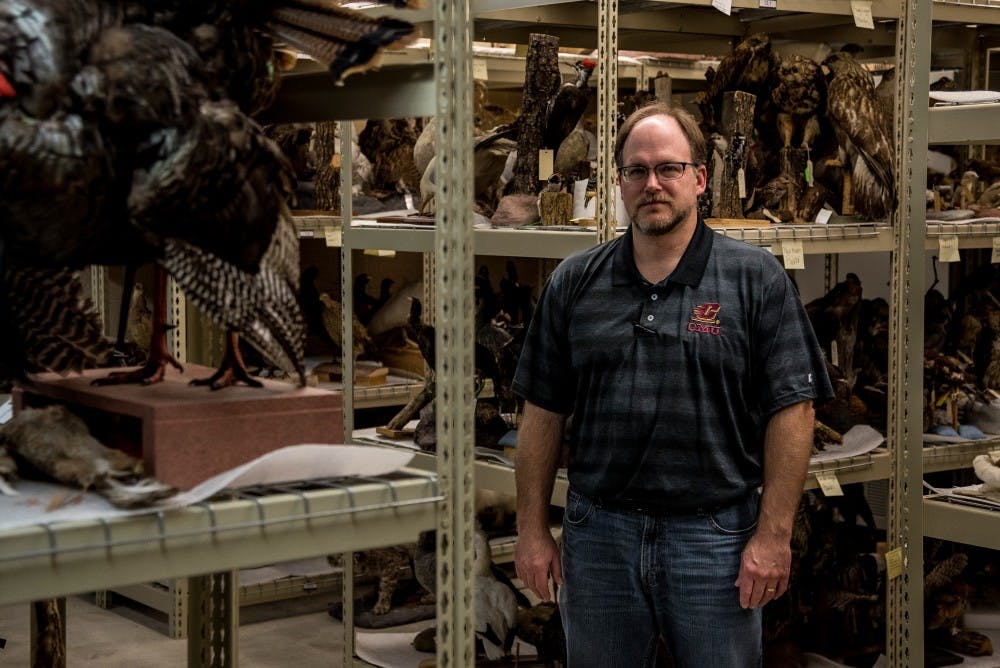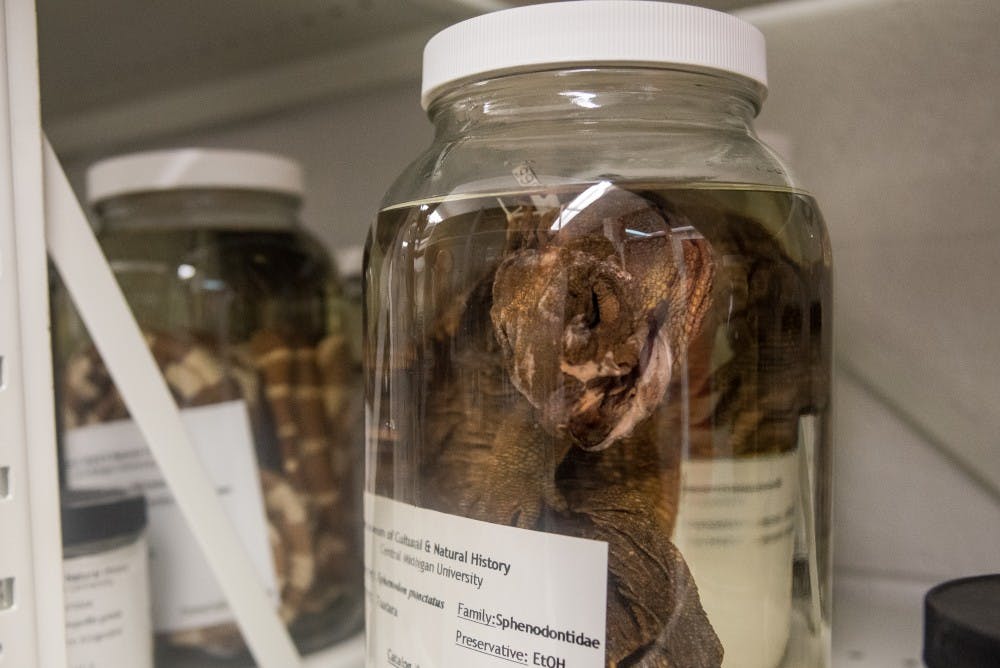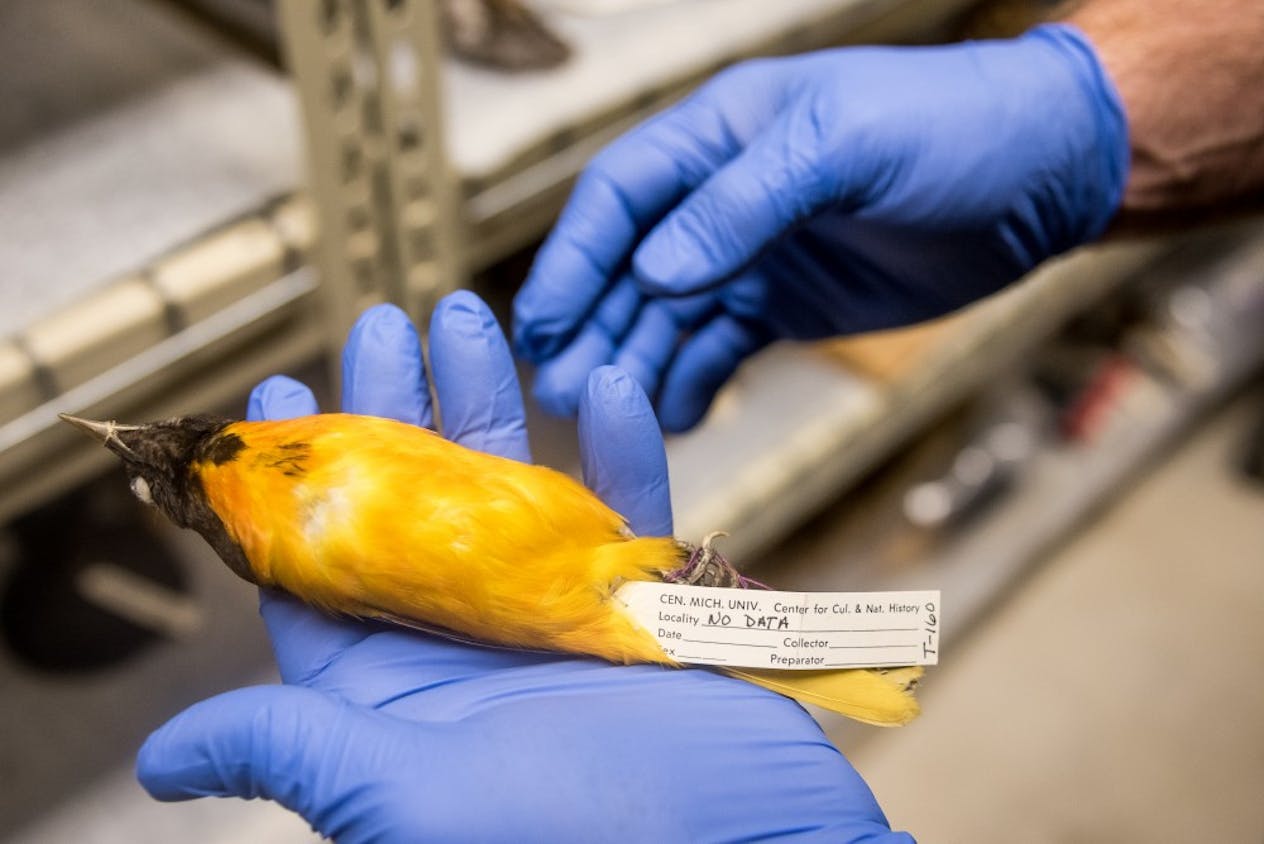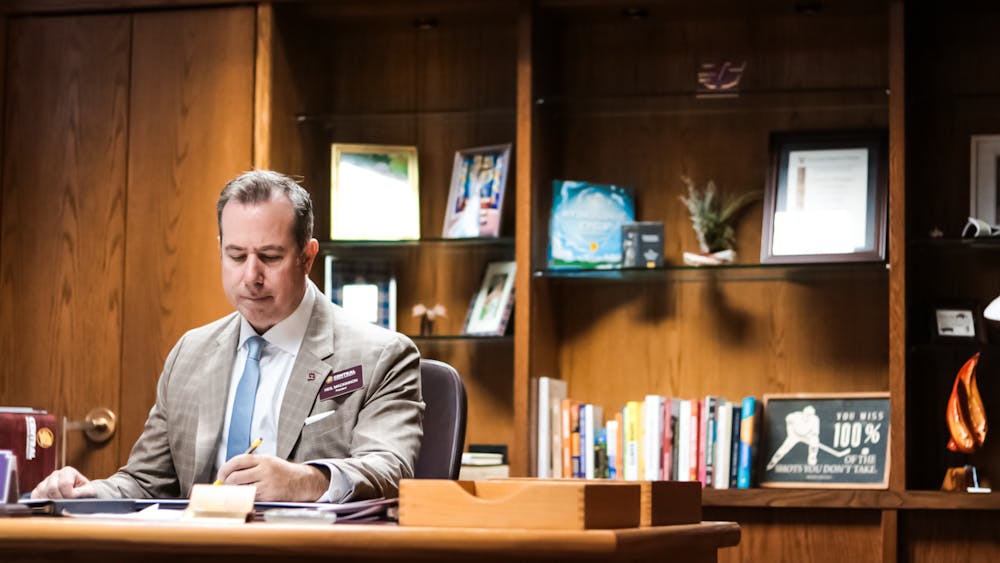'A hidden gem': Taxidermy collection supports CMU education, research

Collections manager Ron Bloomfield stands among the Museum of Cultural and Natural History's exhibition taxidermy collection Oct. 17 in Rowe Hall.
Keys jingle as collections manager Ron Bloomfield digs them out of his pocket and unlocks a heavy metal door, which creaks as he enters a dark room on the first floor of Rowe Hall.
A Liebert power and thermal system roars as it consumes moisture in the air and keeps the space at exactly 68 degrees Fahrenheit. Bloomfield’s hand stumbles across the wall and flicks a light switch on. A zoo of glass eyes stares lifelessly back at Bloomfield.
“They may not hold memories, but they’ll tell you things if you can interpret them,” Bloomfield said.
Central Michigan University’s Museum of Natural and Cultural History has two collections — natural history (zoology and geology) and cultural history (anthropology and history). The collections comprise about 70,000 pieces of CMU history, taxidermy and other cataloged items. The natural history collection makes up about 60 percent of the museum's entire catalog.
The collections are scattered across campus and are used by many faculty members, including biology faculty member Kirsten Nicholson.
Nicholson curated the zoology collection at the museum for more than a decade before becoming a full-time faculty member. She also trained students on how to prepare, care for and maintain taxidermy.

A metal case holds an iguana and caiman sitting in 70 percent ethanol and 30 percent water Oct. 25 at Rowe Hall.
Nicholson divides the zoology collection into three forms:
- Exhibition — life-like representations of animals typically reserved for exhibition purpose or taxidermy.
- Research — study skins kept in a streamlined position suitable for storage and used to gather data.
- Fluid — reptiles, amphibians and fish kept in a glass jar suspended in 30 percent water and 70 percent ethanol.
The university also has a skeletal collection, Nicholson said, which is made up of articulated skeletons, bones, skulls and shells.
Biology faculty member Nancy Seefelt often implements collections into her classes and refers to them as a "hidden gem."
Growing pains
A small room on the second floor of Rowe Hall houses the museum’s fluid collection in one consolidated space. However, the metal shelving, which houses jars of frogs, fish and small reptiles is slowly growing vacant.
Nicholson and Bloomfield recently received a grant from the National Science Foundation. The $126,000 grant will purchase 20 flammable cabinets for the fluid collection to be moved to Brooks Hall, making room on the second floor of Rowe for additional classroom space. It also pays for a graduate assistant, labor and additional supplies.
In the past, Bloomfield said staff had to wear respirators because Formaldehyde levels in the room were too high. The museum is ridding of flammability and health issues by dispersing the collection.
“The fluid objects need so many air exchanges per hour, and should be stored in proper flammable storage cabinets,” Bloomfield said. “This grant allows us to do what’s best for the collection and everyone’s safety,”
Along with an increase in interest, the museum’s zoology collection continues to grow. As a result, Bloomfield has begun dispersing objects around campus.
“It just makes sense to keep everything in the building where they’re needed,” Bloomfield said. “We’ve run out of room in Rowe Hall, so we are making the best of the space we have.”
The museum’s goal is to support instruction, Bloomfield said, and it is now easier for instructors to implement objects into their courses.
Seefelt said for some later ornithology and mammalogy courses, professors previously had to teach courses in the museum. This was problematic because it was hard for students to work with specimens outside of class.
"Its hard to know something while only looking at it for a couple (of) hours a week," Seefelt said. "By moving part of the collection to Brooks Hall, professors gain better access to the resources we need."

A tuatara, a reptile native to New Zealand is suspended in a jar as part of the Museum of Cultural and Natural History's fluid collection Oct. 25 in the a room on the second floor of Rowe Hall.
Supporting education and research
Bloomfield said about 99 percent of the museum’s zoology collection comes from the Great Lakes region. However, the collection has been diversified by contributions from the Detroit Zoo, like a lion skull and a taxidermy flamingo.
While Bloomfield said the zoology collection is comparable to many other universities, the museum's bird collection is the third-largest in the state of Michigan, according to the museum’s website.
The large bird collection results from the interests of former biology faculty members Hal Mahan, an ornithologist who brought a collection of mostly birds with him to CMU, Nicholas Cuthbert and Walter Nickell in the mid-1900s. By the time the museum was founded in 1970, many of the men's specimens were combined with the museum's collection.
In the 90s, Bloomfield said students benefited from learning the taxidermy process. As a result, professors are able to use the collections for research and teaching.
Seefelt benefited from the museum's taxidermy program while volunteering and later working at the museum. Now, she uses the same specimens for research and to teach her classes.
“Ever since I was a child, I have been fascinated with nature and anatomy, so when I was an undergraduate at CMU, I started volunteering at the museum and doing taxidermy," Seefelt said. "My intrigue has continued until the present day.”

Collections manager Ron Bloomfield holds a Baltimore oriole Oct. 25 in the Museum of Cultural and Natural History's taxidermy collection room at Rowe Hall.
Like the zoology collection as a whole, Seefelt said the bird collection draws heavily from the Great Lakes region.
Bloomfield said CMU no longer offers students the opportunity to learn the taxidermy process because of a decline in interest for the art form.
“Before, it was about learning the process of taxidermy. Now, it’s about the fact that we are able to use them in education and research,” he said.
The museum's research and fluid collections are used extensively in the biology department. In early courses, students learn how to analyze data to tell species apart or test hypotheses.
“They are getting some exposure to things they otherwise wouldn’t come in contact with,” Nicholson said. “In later classes, or the ‘ology’s’ as we call them, we have suites of specimens. By the time classes are done, students can go fishing in Michigan and know what they’ve caught.”
The museum's taxidermy collection is used by people outside the biology department. The collection has been used in photography and creative writing projects, art programs as models and educational programs.
Bloomfield said the museum also loans out its collections to researchers looking for data. Anyone can visit the museum’s online database, which provides data about specimens from the Great Lakes region and beyond.






